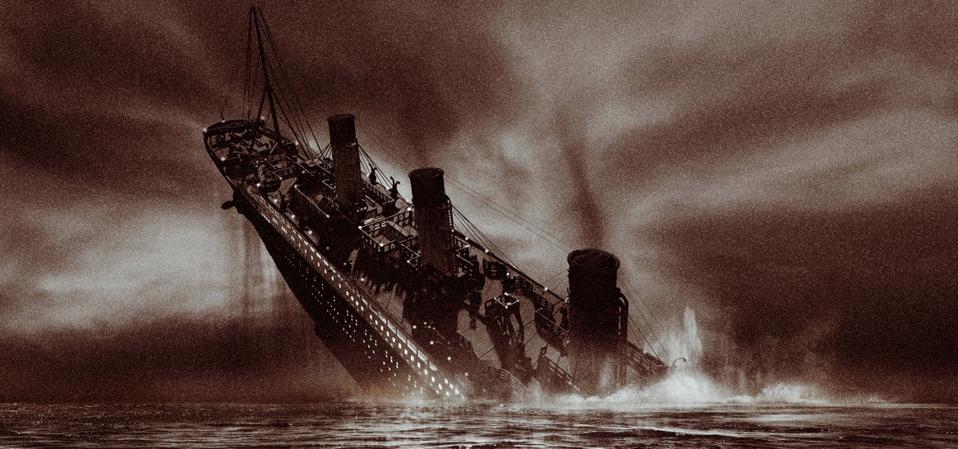Ask someone what they think was the most valuable item lost during the sinking of the Titanic (inanimate, of course) and you’ll probably get answers such as gold, jewelry, cash or precious stones.
It’s true that many of those expensive things were lost forever when the Titanic descended into the depths of the North Atlantic Ocean. And there were other irreplaceable items of great value that were lost as well, including:
- “La Circassienne au Bain” by Merry-Joseph Blondel. A large neoclassical oil painting valued at a significant sum. Its owner, Titanic survivor Mauritz Håkan Björnström-Steffansson, filed for $100,000 in compensation upon arriving in New York (about $2 million by today’s money).
- Jeweled Edition of “The Rubaiyat” by poet Omar Khayyam. A luxurious rare book worth a small fortune at the time it was lost.
- 5 Steinway Grand Pianos. High-quality grand pianos, representing the finest craftsmanship of their time, were lost in the sinking.
- 1912 Renault Type CB Coupe De Ville. A luxurious car, owned by millionaire and first-class passenger William Carter, was among the valuable items swept away by the disaster.
- First Editions of Francis Bacon. Rare first editions of works by the famous artist and philosopher Francis Bacon were among the lost treasures.
- Porcelain. A large collection of fine porcelain, including decorative vases and dinnerware, was among the items that sank with the ship.
- Opium. A quantity of opium, being transported in the cargo hold, was among the illicit items that went down with the ship.
However, the most valuable package lost aboard the Titanic was likely the upwards of 40 crates of exotic bird feathers destined for the workshops of New York milliners (hat makers). Here’s why these feathers commanded such prices on the New York market – as well as the devastating effect the millinery industry had on avian populations.
The Rise Of ‘Feathered Hats’ And The Downfall Of Bird Species
At the turn of the 20th century, New York became the epicenter of the American millinery industry, driven by a growing demand for extravagant and fashionable hats (like these) among the upper classes. Women’s fashion, particularly in the Gilded Age and early 1900s, embraced lavish, highly decorative hats adorned with a variety of exotic materials, including feathers, flowers and even entire bird bodies.
Prominent milliners like Caroline Reboux and Lilly Dache became household names, and their creations were seen as a symbol of status and refinement. The demand for opulent, feathered hats was particularly intense among the wealthy elite.
The use of bird feathers in millinery was not limited to small plumes but extended to the feathers of larger birds, such as egrets, herons and ostriches. The fashion trend of the time led to an insatiable demand for feathers, creating a devastating market for birds.
Ornithologists, conservationists and naturalists began to observe the decline of various bird species, many of which were being hunted in large numbers to meet the growing demand. The Carolina parakeet, native to the southeastern United States, was one such species that suffered tremendously from this practice — ultimately driven to extinction. Its vibrant plumage was highly sought after for hats, leading to widespread hunting and trapping. By the early 20th century, the parakeet population was rapidly diminishing.
(Sidebar: As tragic as the Carolina parakeet’s story is, the United States is also home to a second, lesser-known native parakeet — the green parakeet — which avoided the same fate. See here to learn how it managed to survive in a small pocket of Texas.)
Many of these birds were killed for their feathers during breeding seasons, when they were most abundant and their plumes most impressive. The indiscriminate slaughter of birds for the millinery industry sparked growing awareness about the need for wildlife protection and conservation. This growing environmental crisis culminated in the establishment of the Audubon Society’s early efforts to curb feather hunting and protect bird populations.
As the century progressed, the rise of the millinery industry and its destructive impact on avian species prompted significant legal and social changes. The public outcry against the fashion industry’s role in the destruction of bird populations led to the passage of the Migratory Bird Treaty Act of 1918, which aimed to protect birds from exploitation and hunting. This was a pivotal moment in the history of wildlife conservation, and it marked a turning point in both fashion and environmental responsibility. While the popularity of feathered hats began to wane as the 20th century wore on, the consequences of the millinery boom lingered. For the Carolina parakeet, the damage was irreversible, as the species was officially declared extinct in the early 20th century, a casualty of a fashion trend that would soon be out of favor.
Does thinking about the extinction of a species instantly change your mood? Take the Connectedness to Nature Scale to see where you stand on this unique personality dimension.

